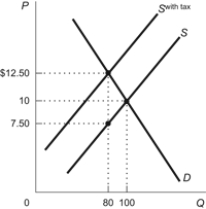Figure: Supply and Demand with Tax on Suppliers 
Using the graph shown, answer the following questions.
a. What was the equilibrium price in this market before the tax?
b. What is the amount of the tax?
c. How much of the tax will the buyers pay?
d. How much of the tax will the sellers pay?
e. How much will the buyer pay for the product after the tax is imposed?
f. How much will the seller receive after the tax is imposed?
g. As a result of the tax, what has happened to the level of market activity?
Definitions:
Social Insurance Program
A government program designed to provide protection against unpredictable financial distress.
Financial Distress
A condition where a company or individual cannot meet or has difficulty meeting financial obligations, leading to potential bankruptcy or restructuring.
Means-Tested Programs
are government assistance programs intended for individuals or families whose incomes and assets fall below specified thresholds.
Temporary Assistance
Short-term aid or support provided by governments or organizations to individuals facing financial hardship or disasters.
Q27: In Medieval Europe, there were two basic
Q59: With a tax on producers, supply:<br>A) increases.<br>B)
Q59: (Figure: Demand, Supply Shifts) In the figure,
Q65: (Figure: Price and Quantity 1) In the
Q95: The United States is the world's largest
Q174: (Figure: Demand Tax) The figure illustrates a
Q192: Figure: Demand Shift <img src="https://d2lvgg3v3hfg70.cloudfront.net/TB3377/.jpg" alt="Figure: Demand
Q205: (Figure: Demand Curve) Refer to the figure.
Q208: (Figure: Wage Subsidy) Consider the use of
Q216: Suppose that war in the Middle East